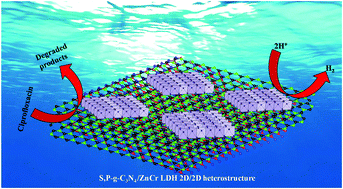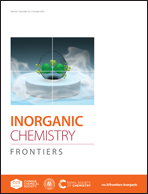Double charge carrier mechanism through 2D/2D interface-assisted ultrafast water reduction and antibiotic degradation over architectural S,P co-doped g-C3N4/ZnCr LDH photocatalyst†
Abstract
The fabrication of a constructive heterostructure and thus the induced 2D/2D interfacial phase indicates great importance in semiconductor based photocatalysts. The energetic electrostatic force of interactions between the positively charged 2D ZnCr LDH nanosheet and the negatively charged 2D S,P co-doped g-C3N4 helps to form a robust heterostructure. By doping S and P simultaneously into the g-C3N4 matrix, the band potentials have been easily engineered for wide range visible light harvesting in comparison to the pure g-C3N4. This innovative 2D/2D S,P co-doped g-C3N4/ZnCr LDH heterostructure interface provides a high surface area and suitable redox potentials for various photocatalytic reactions. The as-fabricated S,P-g-C3N4/ZnCr LDH heterostructure shows considerable enhanced photocatalytic performance for the degradation of ciprofloxacin (95% in 90 min) and H2 evolution (1319 μmol per 2 h) under visible light irradiation as compared to the pure material (g-C3N4, S,P-g-C3N4, and LDH nanosheet) and mono-doped heterostructure. The enhanced photocatalytic activities attributed to the loading of the ZnCr LDH nanosheet onto the surface of the S,P co-doped g-C3N4 allows effective interfacial charge mobility and transfer through intimate 2D/2D interfacial contact. In addition, the co-doping also generates some defect sites in the heterostructure that act as trapping centers for photogenerated charge pairs and the excess unpaired electrons of S and P atom delocalized in the π-conjugated triazine ring, constructing a rich-electron state, which is beneficial for the photocatalytic process. XRD, FTIR, and TEM studies of the reused composite show that the heterostructure hybrid material is very stable and can be reused many times. Our innovation in the fabrication, design, and physicochemical behaviours of the 2D/2D heterostructure may get utilized in different photocatalytic performances towards antibiotic degradation and H2 production.



 Please wait while we load your content...
Please wait while we load your content...